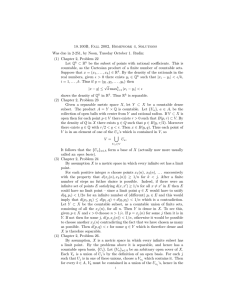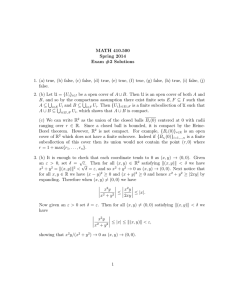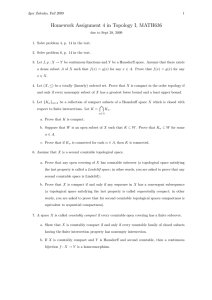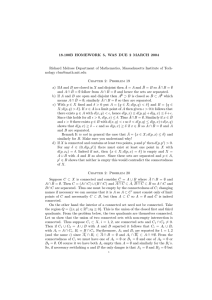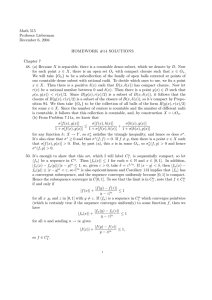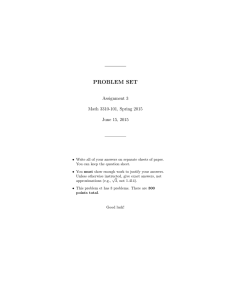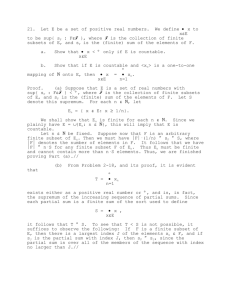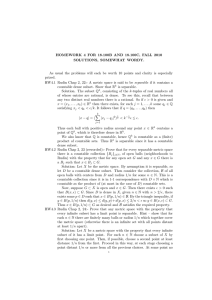Chapter 2: Problem 10
advertisement
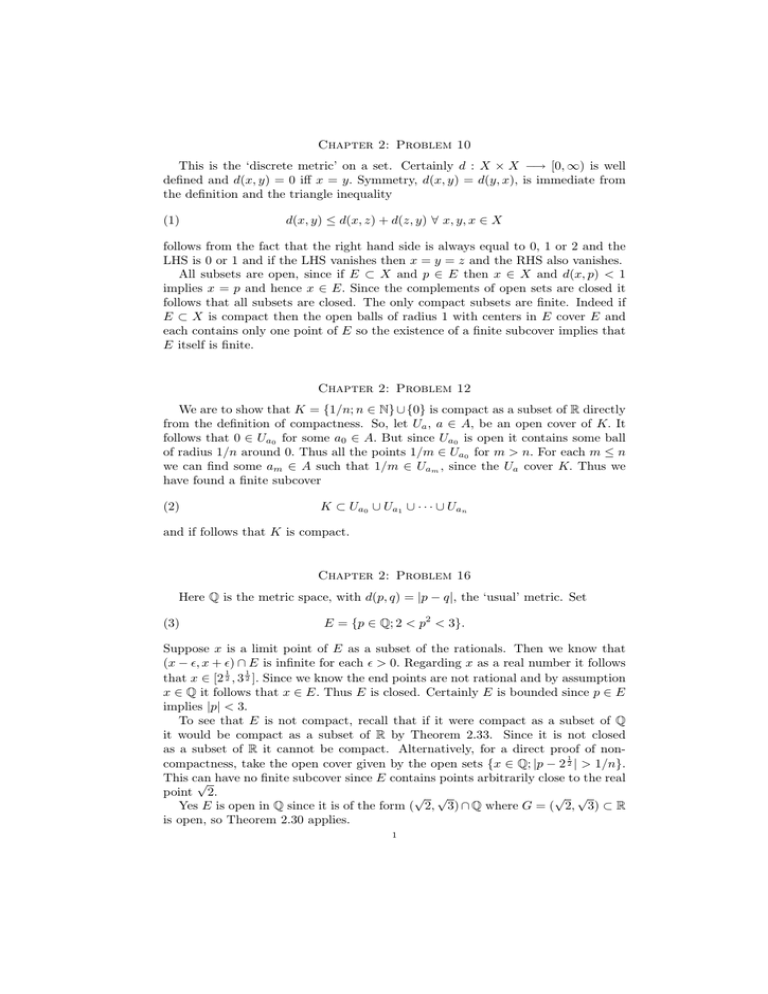
Chapter 2: Problem 10
This is the ‘discrete metric’ on a set. Certainly d : X × X −→ [0, ∞) is well
defined and d(x, y) = 0 iff x = y. Symmetry, d(x, y) = d(y, x), is immediate from
the definition and the triangle inequality
(1)
d(x, y) ≤ d(x, z) + d(z, y) ∀ x, y, x ∈ X
follows from the fact that the right hand side is always equal to 0, 1 or 2 and the
LHS is 0 or 1 and if the LHS vanishes then x = y = z and the RHS also vanishes.
All subsets are open, since if E ⊂ X and p ∈ E then x ∈ X and d(x, p) < 1
implies x = p and hence x ∈ E. Since the complements of open sets are closed it
follows that all subsets are closed. The only compact subsets are finite. Indeed if
E ⊂ X is compact then the open balls of radius 1 with centers in E cover E and
each contains only one point of E so the existence of a finite subcover implies that
E itself is finite.
Chapter 2: Problem 12
We are to show that K = {1/n; n ∈ N} ∪ {0} is compact as a subset of R directly
from the definition of compactness. So, let Ua , a ∈ A, be an open cover of K. It
follows that 0 ∈ Ua0 for some a0 ∈ A. But since Ua0 is open it contains some ball
of radius 1/n around 0. Thus all the points 1/m ∈ Ua0 for m > n. For each m ≤ n
we can find some am ∈ A such that 1/m ∈ Uam , since the Ua cover K. Thus we
have found a finite subcover
(2)
K ⊂ Ua0 ∪ Ua1 ∪ · · · ∪ Uan
and if follows that K is compact.
Chapter 2: Problem 16
Here Q is the metric space, with d(p, q) = |p − q|, the ‘usual’ metric. Set
(3)
E = {p ∈ Q; 2 < p2 < 3}.
Suppose x is a limit point of E as a subset of the rationals. Then we know that
(x − , x + ) ∩ E is infinite for each > 0. Regarding x as a real number it follows
1
1
that x ∈ [2 2 , 3 2 ]. Since we know the end points are not rational and by assumption
x ∈ Q it follows that x ∈ E. Thus E is closed. Certainly E is bounded since p ∈ E
implies |p| < 3.
To see that E is not compact, recall that if it were compact as a subset of Q
it would be compact as a subset of R by Theorem 2.33. Since it is not closed
as a subset of R it cannot be compact. Alternatively, for a direct proof of non1
compactness, take the open cover given by the open sets {x ∈ Q; |p − 2 2 | > 1/n}.
This can
√ have no finite subcover since E contains points arbitrarily close to the real
point 2.
√ √
√ √
Yes E is open in Q since it is of the form ( 2, 3) ∩ Q where G = ( 2, 3) ⊂ R
is open, so Theorem 2.30 applies.
1
2
Chapter 2: Problem 22
We need to show that the set of rational points, Qk is dense in Rk . We can use
the fact that Q ⊂ R is dense. Thus, given > 0 and x = (x1 , . . . , xk ) ∈ Rk there
exists pl ∈ Q such that |xl − pl | ≤ /k for each l = 1, . . . , k. Thus, as points in Rk ,
|x − p| ≤
(4)
k
X
|xl − pl | < .
l=1
This shows that Rk is separable since we know that Qk is countable.
Chapter 2: Problem 23
We are to show that a given separable metric space, X, has a countable base.
The hint is to choose a countable dense subset E ∈ X and then to consider the
collection, B, of all open subsets of X of the form B(x, 1/n) where x ∈ E and n ∈ N.
This is a countable union, over N, of countable sets so is countable. Now, we need
to show that this is a base. So, suppose U ⊂ X is a given open set. If x ∈ U then
for some m = mx > 0, B(x, 1/m) ⊂ U, since it is open. Also, by the density of E
in X there exists some ex ∈ E with |x − ex | < 1/2m But then y ∈ B(ex , 1/2m)
implies d(x, y) < d(x, ex ) + d(ex , y) < 1/2m + 1/2m = 1/m. Thus B(ex , 1/2m) ⊂ U.
It follows that
[
(5)
U=
B(ex , 1/2mx ).
x∈U
Thus U is written as a union of the elements of B which is therefore an open base.
Chapter 2: Problem 25
We wish to show that a given compact metric space K has a countable base. As
the hint says, for each n ∈ N consider the balls of radius 1/n around each of the
points of K :
[
(6)
K⊂
B(x, 1/n)
x∈K
since each x ∈ K is in one of these balls at least. Now the compactness of K implies
that there is a finite subcover, that is there is a finite subset Cn ⊂ K, for each n,
such that
[
(7)
K⊂
B(p, 1/n).
p∈Cn
S
Now, set E = n∈N Cn . This is countable, being a countable union of finite sets.
Now it follows that C is dense in K. Indeed given x ∈ K and > 0 there exists
n ∈ N with 1/n < and from (7) a point in p ∈ Cn ⊂ C with |x − p| < 1/n < .
Thus K = C and it follows that K is separable; from #23 it follows that K has a
countable open base.
Alternatively one can see directly that the B(p, 1/n), p ∈ Cn , form an open base.
Department of Mathematics, Massachusetts Institute of Technology
E-mail address: rbm@math.mit.edu
